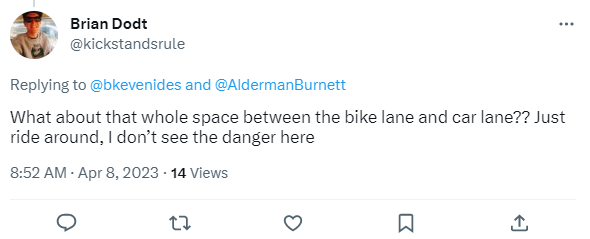Go Around! Not so fast...
An SUV blocks the bike lane on Milwaukee Avenue in Chicago on April 6, 2023 as a person on a bike rides by.
Bicycle lanes have become increasingly common in cities around the world as a way to encourage cycling as a mode of transportation. However, despite the clear markings and signage indicating that these lanes are for bicycles only, many motor vehicle drivers continue to park in them. This is not only a violation of the law but also a significant danger to cyclists. In this blog post, we will explore why it is so dangerous for motor vehicles to park in bicycle lanes.
A Twitter user’s response to the photo of the blocked bike lane above.
Firstly, when a motor vehicle is parked in a bicycle lane, it forces cyclists to merge back into traffic, which can be extremely dangerous. Cyclists are already vulnerable on the road, and merging back into traffic can increase their risk of being hit by other vehicles. In addition, drivers may not expect cyclists to suddenly merge into traffic, leading to confusion and potential accidents.
Secondly, parked motor vehicles in bicycle lanes create a physical barrier that can be difficult for cyclists to navigate around. This can force cyclists into the path of other vehicles or onto the sidewalk, endangering pedestrians. It can also result in cyclists having to make sudden and unexpected movements, increasing the risk of collision with other vehicles or pedestrians.
Thirdly, parking in bicycle lanes sends a message to drivers that they do not need to respect the safety of cyclists. This can lead to further unsafe behaviors, such as passing too closely to cyclists or ignoring other traffic laws. It also creates a culture where cyclists are not seen as legitimate road users, which can lead to harassment and hostility towards cyclists.
Finally, parking in bicycle lanes can have a negative impact on the environment. Bicycle lanes are an important component of a city's infrastructure for promoting sustainable transportation. When motor vehicles park in these lanes, it can discourage people from cycling, which in turn can increase reliance on cars and contribute to air pollution and congestion.
In conclusion, parking in bicycle lanes is a dangerous and irresponsible behavior that poses a significant risk to cyclists. It forces cyclists to merge back into traffic, creates physical barriers that are difficult to navigate around, sends a message to drivers that cyclists are not legitimate road users, and can discourage sustainable transportation. It is important for drivers to respect bicycle lanes and understand the importance of sharing the road with all users. Cities can also take steps to enforce parking regulations and increase education and awareness around the importance of bicycle lanes for safe and sustainable transportation.


